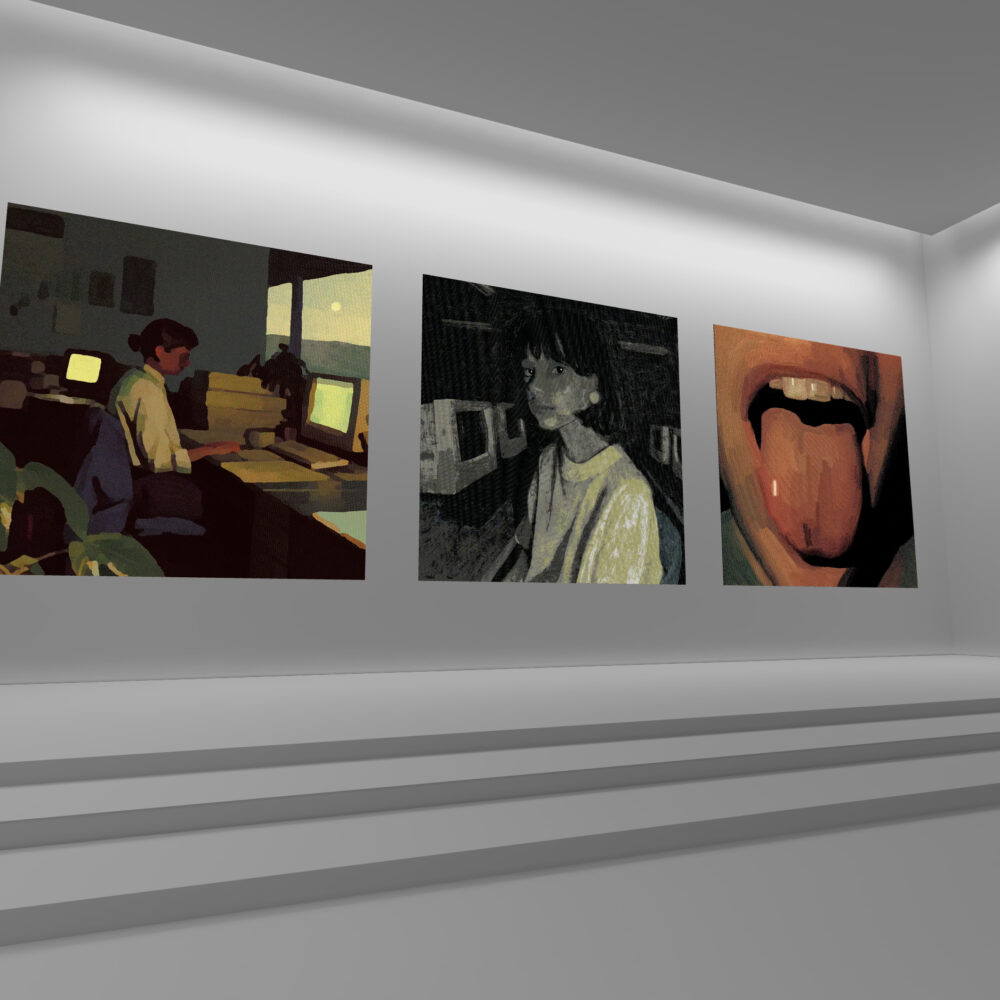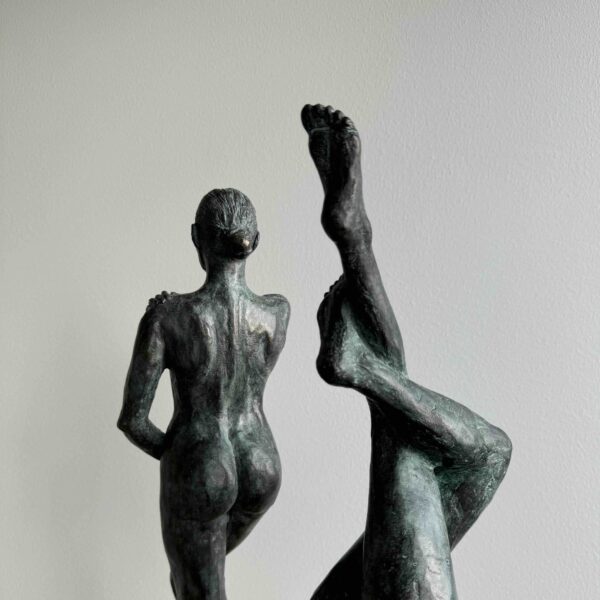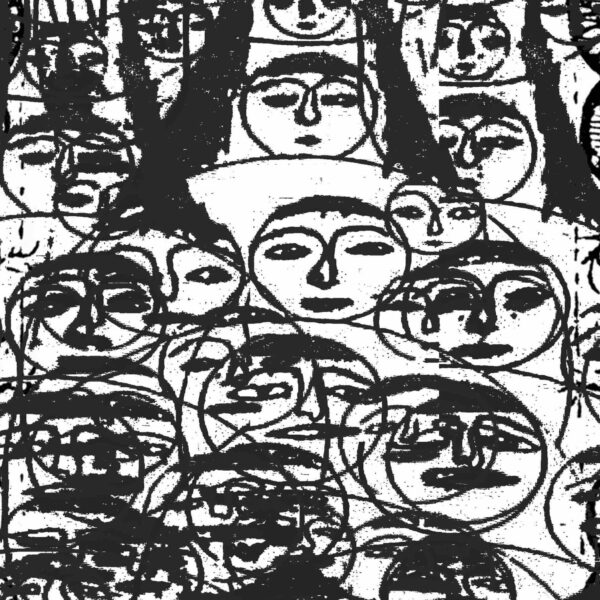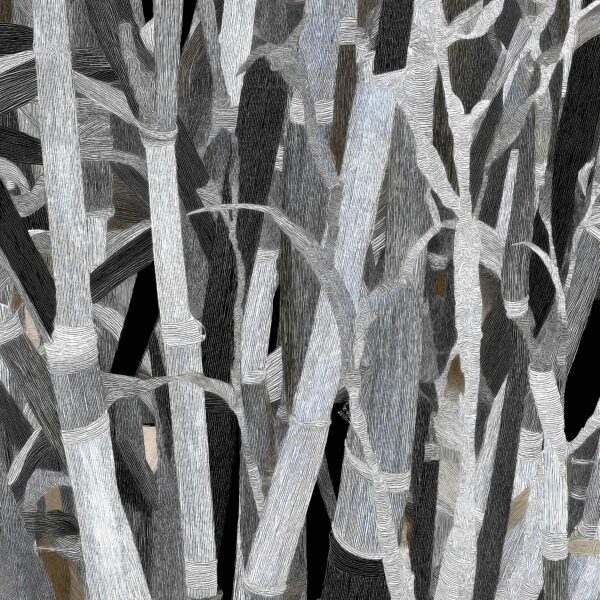Reflecting on the Convergence of Past, Present, and Future: The AiR III Exhibition at AOTM
The Artists in Residence (AiR) III exhibition at AOTM stands as a testament to the power of digital art to bridge time, explore the human psyche, and envisage future interrelations between humanity and technology. Through the diverse yet interconnected works of aditya, Sabato, and Yudho, the exhibition offers a deep dive into themes of historical innovation, personal struggle, and speculative futures, providing rich narratives that resonate deeply with contemporary audiences.

Aditya: Chronicling the Inner Landscape
Aditya’s artworks engage deeply with themes of psychological turmoil and societal critique, rendered through vivid digital animations that blend visual appeal with emotional depth. “Toxic patterns” illustrates the crushing repetitiveness of modern life, with its protagonist caught in a never-ending cycle that symbolically represents the broader human condition under the pressures of contemporary societal structures. This looping animation serves as a stark reminder of the often overlooked mental health issues stemming from monotonous routines.
In “An unbearable sadness,” aditya shifts his focus inward, portraying a deep-seated emotional isolation. This piece brings the viewer into a close, almost uncomfortable proximity to the subject, whose momentary gaze into the viewer’s space breaks the fourth wall, creating a fleeting connection that underscores the profound loneliness depicted. The artwork’s stark, minimalistic animation style intensifies the sense of isolation, making the viewer acutely aware of the emotional weight being conveyed.
“Release” confronts the commodification of mental well-being in a strikingly direct manner. The depiction of a pill, consumed to manage or manipulate emotional states, critiques the pharmaceutical approach to mental health and comments on the broader societal implications of such practices. This piece challenges the viewer to consider the ethical dimensions of mental health treatment in the modern age.
Sabato: Revisiting Aerial Innovations through Pixels
Sabato’s works serve as a pixelated chronicle of the early days of aviation, encapsulating moments of human triumph and the exhilarating spirit of early flight pioneers. “Santos-Dumont 14-Bis, Le Oiseau de Proie, 1906” not only visually narrates a historical event but does so using the digital medium to imbue the scene with a sense of nostalgia and innovation, reflecting on how these early flights captivated the public imagination and pushed technological boundaries.
“Santos-Dumont No. 9, La Baladeuse” portrays an equally significant historical moment with Aida de Acosta at the helm, highlighting her pioneering role in aviation history. This artwork not only recounts her flight but also celebrates her breaking of gender barriers in the early 20th century, providing a nuanced look at the intersection of technological and social advances.
The series is rounded off with “Santos-Dumont No. 6 Over Parc Saint Cloud,” which captures another landmark event in aviation. This artwork extends the narrative of communal achievement and technological progress, emphasizing the collective excitement and societal impact of Santos-Dumont’s achievements in a visually engaging pixel art format.
Yudho: Pixelated Projections of Human Existence
Yudho’s contributions examine the intersection of human existence with technology, presenting stark visions of our spiritual and existential journeys through meticulously crafted pixel art. “The Echo of Faith” visually meditates on the search for spiritual meaning, symbolizing how personal faiths are reflected and often distorted in the turbulent waters of modern life. This artwork encourages viewers to reflect on their own beliefs and the role of spirituality in an increasingly digital world.
“Humanity’s Ascension” further explores the impact of human advancement, depicting a figure either ascending or dissolving into a cloud of pixels, representing the dual nature of progress—both constructive and destructive. This piece prompts a contemplation of the environmental and ethical implications of our relentless pursuit of advancement.
Completing his trilogy, “The God We Built” speculates on a future where artificial intelligence takes on a god-like role in society. This artwork challenges viewers to consider the implications of our creations, suggesting that the AI we build might ultimately redefine what it means to be human, reflecting our desires, fears, and futures.
A Tapestry of Digital Narratives
Collectively, the artworks featured in AiR III at AOTM weave a complex tapestry that traverses historical insights, emotional explorations, and futuristic speculations. Each piece, rich with thematic depth and rendered through innovative digital techniques, invites viewers into a reflective dialogue on the role of technology in shaping human narratives. This exhibition is not just a showcase of digital art; it is a profound exploration of the ways in which our creations, from airplanes to AI, continue to reshape our worldviews, our societies, and our inner selves.


